
Do you have a question about the Carrier 62X Series and is the answer not in the manual?
| Brand | Carrier |
|---|---|
| Model | 62X Series |
| Category | Air Handlers |
| Language | English |
General information about the 62X unit, its function as a DOAS, and its typical usage.
Describes how outdoor air enters and moves through the 62X unit.
Details the components and operation of the 62X unit's refrigeration system.
Explains the different heating options available for the 62X unit, including gas, electric, and hot water.
Explains how the unit's control configuration is set up and how field modifications affect it.
Details the communication methods and ports available for the controller, including Rnet and BAS communication.
Describes the accessory touchscreen device for unit interface, configuration, and monitoring.
Overview of the Equipment Touch device and its capabilities for managing HVAC equipment.
Instructions for connecting the Equipment Touch 2 device to the unit controller.
Guidance on using the Equipment Touch 2 interface for intuitive control navigation and operation.
Explains the user levels (User, Admin, Factory) and password requirements for accessing unit settings.
How unit options and configurations affect displayed screens and available tests.
Describes the screen displayed when the Equipment Touch has been idle.
Main access point to unit operations, status screens, and set point/technical settings.
Provides information on component status without allowing edits.
Shows the status of the outdoor air damper, smoke detector, and energy management relay.
Displays status and parameters for the supply fan and clogged filter indicator.
Shows status and parameters for the exhaust fan.
Displays status and parameters for the Energy Conservation Wheel (ECW).
Shows status and parameters for cooling mode, including compressor and condensate overflow.
Displays status and parameters for liquid subcooling and hot gas reheat.
Shows status and parameters for dehumidification mode.
Displays status and parameters for the unit's heat source.
Shows status and parameters for heat pump units (62H and 62W only).
Accesses screens for all available component, safety, and mode set points.
Lists operating set points, applicable devices, referencing sensors, and units.
Displays set points for supply and exhaust fans, including airflow and pressure control methods.
Shows set points for the energy conservation wheel, including defrost.
Displays set points for the first stage of cooling and cooling mode.
Shows set points for the second stage of cooling (available on units 10 tons and larger).
Displays set points and deadband for dehumidification mode.
Shows set points and deadbands for the heat source and heating mode.
Displays set points and parameters for heat pump heating mode.
Shows set points for unit safeties, including lockouts and freeze protection.
Displays set points for unoccupied operation.
Displays and allows modification of unit control configuration information.
Configures zone sensor options for energy purposes like ZAT/SAT reset.
Allows zone sensors with push-button override to enter occupied mode.
Allows zone sensors to adjust the zone air temperature set point.
Sets a limit for how far set point overrides can adjust.
Configures night setback operation using recirculated air during unoccupied mode.
Used for safety control options like clogged filter indicator and smoke detector.
Used for shutdown/occupancy control options like EMR and EMSD.
Determines how the unit operates between occupied and unoccupied/disabled modes.
Displays and allows adding local schedules for unit operation.
Displays and allows adjustment of unit sensor calibration settings.
Displays set points for SAT reset operation based on zone air temperature.
Allows overriding modulating components for troubleshooting or start-up.
Displays status and links to AMS settings for supply and exhaust fans.
Displays AMS settings for supply and exhaust fans.
Contains settings related to the unit controller, Equipment Touch, and technical settings.
Links to screens for setting up network communication with the 62X controller.
Sets the BACnet device ID and other related networking settings.
Selects communication type and enters router address for BAS setup.
Determines how the unit supply fan is controlled (VFD AMS, CAV, DPT, etc.).
Determines how the unit exhaust fan is controlled (VFD AMS, CAV, DPT, etc.).
Determines how the reheat system functions.
Determines how dehumidification mode functions.
Determines how the heating system functions.
Determines when cooling mode is enabled.
Determines when heating mode is enabled.
Determines what temperature sensors the supply control will look for.
Determines what temperature sensors the exhaust control will look for.
Determines what humidity sensors the supply control will look for.
Determines what humidity sensors the exhaust control will look for.
Determines what DPT sensors the control will look for.
Displays control program archive status, date, and update options.
Restores the controller's program from the last archive or factory default.
Steps to create a field archive for backup or restoration.
Steps to restore the factory archive, warning about data loss.
Steps to restore a previously created field archive.
Explains scheduling options and occupancy control sources.
Details the sequence of operations when the unit is in occupied mode.
Describes the operation of the outdoor air damper.
Explains the operation of the supply fan, including speed control.
Explains the operation of the exhaust fan, including speed control.
Explains how SAT reset adjusts the supply air temperature set point based on zone air temperature.
Details ECW operation, including standard, defrost, and VFD defrost modes.
Explains the conditions and logic for initiating and operating the cooling mode.
Describes the conditions and operation for dehumidification mode.
Explains the conditions and operation for heating modes, including staged and modulating heat.
Describes what happens when the unit transitions to unoccupied mode.
Details the function and response of safety switches like HPS and LPS.
Indicates active alarms and how they are visually represented on the Home screen.
Describes the options available on the Alarms Screen for viewing and managing alarms.
Procedures for clearing active alarms from the Equipment Touch.
Lists alarm events and their corresponding condition/mode statuses.
Describes alarms that reset automatically when the condition is corrected.
Describes alarms that require manual reset.
Notes that alarms may occur after startup and suggests checking connections.
Details the High Pressure Switch (HPS) and Low Pressure Switch (LPS) functions.
Explains safety shutdowns triggered by smoke detectors, pressure lockouts, or sensor failures.
A list of all sensors, their descriptions, factory installation status, and part numbers.
Step-by-step instructions for installing the Zone Air Temperature sensor.
Specifications for the Zone Air Temperature sensor.
Diagram showing mounting specifications for the ZS sensor.
Diagram illustrating Rnet cable connection for the sensor.
Diagram showing Rnet cable construction.
Diagram of Rnet terminal connections for the sensor.
Diagram showing correct wire positioning for sensors.
Instructions for wiring and setting up multiple ZS sensors in a daisy chain.
Wiring diagram for multiple ZS sensors.
Instructions for installing and wiring the SAT/RH sensor.
Guidelines for mounting the SAT/RH transmitter in the duct.
Steps for wiring and configuring the SAT/RH sensor.
Diagram showing dimensions of the SAT/RH sensor.
Specifications for the SAT/RH sensor.
Wiring diagram for the SAT/RH sensor.
Diagram showing SAT/RH sensor output configuration.
Wiring and configuration steps for the controller related to the SAT/RH sensor.
Wiring diagram for SAT/RH sensor to controller.
Step-by-step instructions for installing the DPT.
Diagram showing DPT dimensions.
Specifications for the DPT.
Diagram illustrating DPT wiring connections.
Information on the clogged filter indicator (CFI) and its wiring.
Specifications for the Clogged Filter Indicator.
Instructions for setting up the phase monitor.
How to reset the phase monitor.
Specifications for the phase monitor.
Diagram showing phase monitor details.
Wiring diagram for the EMR.
Details the three ways the VFD can be controlled for fans.
Diagram for DC1 VFD control.
Supply fan parameter settings for 0-10V control.
Exhaust fan parameter settings for 0-10V control.
ECW parameter settings for 0-10V control.
Diagram of the Cometer.
Table of K-factors for blowers.
Explains variable speed control for condenser fans.
Parameters for condenser fan head pressure control.
Wiring diagram for VFD pressure transducer control.
Control set points for gas or electric heat.
Details the electronic ignition control for gas heat units.
Explains fault conditions and LED codes for the ignition control module.
Diagram of the controller.
Procedure for testing the flame current sensor.
Steps for checking flame current.
Diagram for flame current detection.
Lists LED codes and their meanings for the ignition control.
Steps involved when a call for heat is initiated.
Procedures for recovering from an ignition control lockout.
Lists LED flash codes and their meanings for ignition control faults.
Lists LED codes and their meanings.
Diagram for draft fan pressure measurement.
Details on modulating gas heat operation and components.
Example of a modulating gas valve.
Explains the function of the signal conditioner for gas valves.
Diagram of a modulating gas valve.
Diagram of the signal conditioner.
Information on controlling inducer fan speed.
Explains the function of the Timer Relay Control (TR1).
Diagram of inducer fan speed control.
Diagram of the TR1 timer relay.
Detailed sequence of operation for electronic modulation with inducer speed control.
Wiring diagram for modulating heat.
Wiring diagram for two-stage, three-element electric heat.
Details on SCR controlled electric heat operation and power control.
Power switch settings for SCR control.
Wiring diagram for two-stage, six-element electric heat.
Wiring diagram for four-stage, nine-element electric heat.
Diagram of the SCR power control.
Wiring diagram for SCR control electric heat.
Details on ERV VFD control for frost prevention.
Maintenance procedures for ERV components like bearings, motors, belts, VFDs, and filters.
Maintenance for ERV bearings.
Maintenance for the ERV motor.
Maintenance for the ERV belt.
Maintenance for the ERV VFD.
Maintenance for the ERV bypass.
Maintenance for ERV filters.
Maintenance for ERV seals.
Information on ERV wheel maintenance and cleaning.
References for typical wiring information.
Typical wiring diagram.
Continuation of the typical wiring diagram.
Continuation of the typical wiring diagram.
Continuation of the typical wiring diagram.
Continuation of the typical wiring diagram.
Continuation of the typical wiring diagram.
Continuation of the typical wiring diagram.
Wiring diagram for units with inverter-driven compressors.
Continuation of the wiring diagram for inverter-driven compressor units.
Continuation of the wiring diagram for inverter-driven compressor units.
Continuation of the wiring diagram for inverter-driven compressor units.
Continuation of the wiring diagram for inverter-driven compressor units.
Continuation of the wiring diagram for inverter-driven compressor units.
Continuation of the wiring diagram for inverter-driven compressor units.
Instructions for addressing the LS-1628 controller on a network.
How to configure autobaud settings for serial networks.
Information on using ARC156 networking with the LS-1628 controller.
Steps for configuring the LS-1628 for ARC156 communication.
How to define IP addressing for controller network communication.
How to set the address and baud rate for Port S2.
Instructions for connecting the controller to Ethernet.
Wiring instructions for BACnet/ARCNET networks.
Specifications for communication wiring.
Wiring details for LS-1628 communication ports.
Lists the unit's operating modes and their corresponding values.
Lists the unit's operating conditions and their corresponding values.
Checklist for preparing the unit before installation.
Steps to verify the unit has been installed correctly.
Checklist for setting up the unit after installation.
Instructions for ensuring condensate traps are installed and draining properly.
Ensures all electrical connections in the control box are tightened.
Verifies field-installed sensors are wired and configured correctly.
Confirms crankcase heaters are operational.
Checks supply fan rotation, obstructions, and controls.
Checks exhaust fan rotation, obstructions, and controls.
Verifies ECW rotation, belt tension, and filter status.
Checks condenser fan rotation and coil condition.
Verifies unit clearance from surrounding objects.
Checks gas piping, pressure, and condensate trap installation.
Verifies hot water coil installation and freeze protection.
Verifies unit power, controller power, and control interface installation.
Confirms customer needs for set points and control methods.
Verifies how unit occupancy is controlled.
Verifies unit networking setup for BAS integration.
Provides tips for unit start-up using the Equipment Touch interface.
Covers basic setup and controller pre-configuration.
Fields for project details, installer information, and unit details.
Verifies equipment configuration settings against the pre-startup checklist.
Verifies Tech Settings configurations against the pre-startup checklist.
Verifies configuration of zone sensor, overrides, setpoints, options, and unit control.
Verifies SAT reset parameters are set correctly.
Verifies DPT range settings for pressure control.
Verifies manual override outputs are set to "Off".
Verifies all sensor offsets are set to "0.00".
Verifies the controller's current time and date are set.
Verifies setpoints for fans, ECW, cooling, dehum, heating, limits, and unoccupied modes.
Sets fan set points for static pressure, airflow, and modulation.
Sets the ECW defrost set point.
Sets cooling 1 enable and modulation set points.
Sets cooling 2 enable set points.
Sets dehum enable and SAT set points.
Sets heating enable and SAT set points.
Adjusts limits and safety set points as needed.
Adjusts unoccupied set points for cooling, heating, and dehum.
General instructions for completing the air balance checklist.
Reviewing the unit submittal for fan and airflow information.
Pre-checks before starting the air balance procedure.
Steps to enable test mode and configure fans for air balancing.
Procedure for balancing fans in constant speed mode.
Balancing procedure for fans controlled by pressure.
Balancing procedure for fans controlled by airflow monitors.
Verifying test mode is disabled after balancing.
Ensures test mode is turned off.
Ensures manual overrides are off unless set by air balance.
Ensures sensor offsets are off unless set by calibration.
Confirms the controller's time and date are correctly set.
Ensures emergency shutdown is set to OFF.
Ensures manual occupancy control is set to OFF.
Confirms configured occupancy control matches the last known setting.
Ensures unit operation is enabled.
Checks that no alarms are active before leaving the unit.


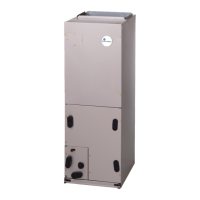
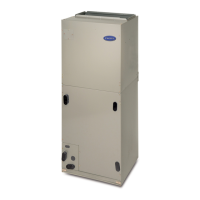


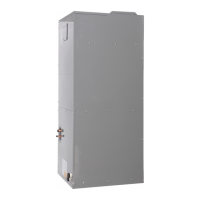

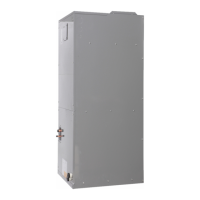
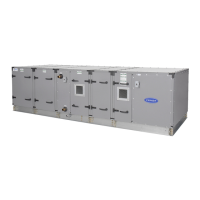

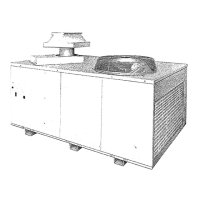
